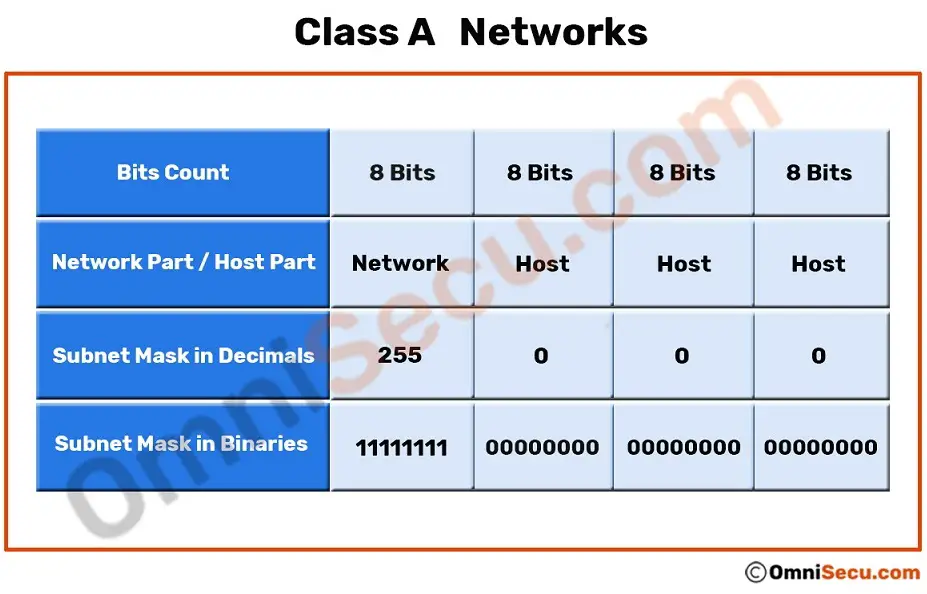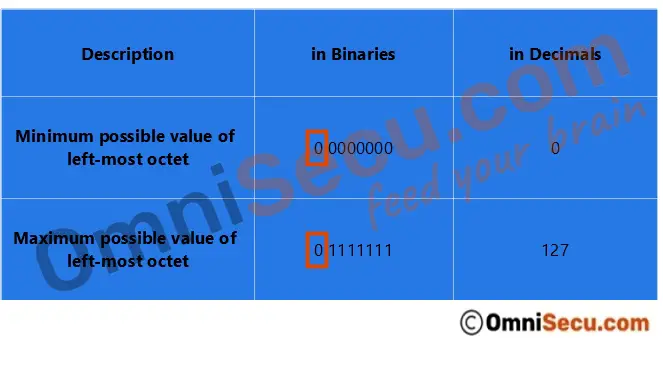Class A networks and Class A IP addresses
"Class A" IPv4 addresses are for very large networks. Please note below important points about Class A network IP addresses.
- First octet of a "Class A" network IP address is used to identify the "Network part" and the remaining three octets are used to identify a host uniquely within that network.
- The default structure of a Class A IP address is Network.Host.Host.Host
- The left-most bit (also called as high-order bit or most-significant bit) of the left most octet of a "Class A" network is reserved as "0".
I strongly suggest you to visit and learn below lessons before you continue learning more about Class A networks and Class A IP addresses.
- IPv4 Addresses
- What is subnet mask
- What is network address
- Binary Decimal and Hexadecimal numbers and conversions
- Five layered TCP/IP model
- Network Layer (Layer 3)
- IPv4 Protocol, IPv4 header and fields of IPv4 header
- Media Access Control (MAC) addresses
- Limited broadcast address
- Directed broadcast address
- What is Loopback address
Structure of a Class A IP address
The left-most octet of a Class A network IP address belongs to the network part and remaining three octets belongs to the host part. The structure of a Class A IP address is Network.Host.Host.Host. The default subnet mask of a Class A IP address is 255.0.0.0.
Please refer below image.

Address range of Class A IP addresses
Since the left-most bit (also called as high-order bit or most-significant bit) of the first octet of a Class A network IPv4 address is reserved as "0", the 32 bits of a "Class A" address can be represented as 0xxxxxxx.xxxxxxxx.xxxxxxxx.xxxxxxxx.
The minimum possible value for the left-most octet in binaries is 00000000 (decimal equivalent is 0) and the maximum possible value for the left-most octet is 01111111 (decimal equivalent is 127). Therefore for a "Class A" IPv4 address, left-most octet must have a value between 0-127 (0.X.X.X to 127.X.X.X). Also note that the starting Class A IP address is 0.0.0.0 and last Class A IP address is 127.255.255.255.
Following image shows the range (minimum and maximum possible values) of left-most octet of a Class A network IP address. Note that the most-significant bit in left-most octet is reserved as "0" for a Class A network IP address. Most-significant bit in the left-most octet is marked inside an orange rectangle in below image.

You can easily identify a Class A IP address by looking at its left-most octet. If the left most octet is between (and including) 0 and 127, it is a Class A IP address.
Since the default structure of a Class A IP address is Network.Host.Host.Host, the default subnet mask of a Class A IP address is 255.0.0.0.
Reservation of IP addresses in Class A networks
An important IP address reservation in Class A IPv4 addresses is private network 10.0.0.0. 10.0.0.0 network belongs to "Class A" is reserved for private use and can be used inside any organization. Computers which are not connected directly to the Internet do not need globally-unique IPv4 addresses. They need an IPv4 addresses unique to that network only. Private IP addresses are used for that purpose.
Another important reservation is loopback network 127.0.0.0. The network 127.0.0.0 is known as loopback network. The IPv4 addresses in 127.0.0.0 network are used by the host computer to send a message back to itself. It is commonly used for troubleshooting and network testing. Click following link to learn more about loopkack network IP addresses.